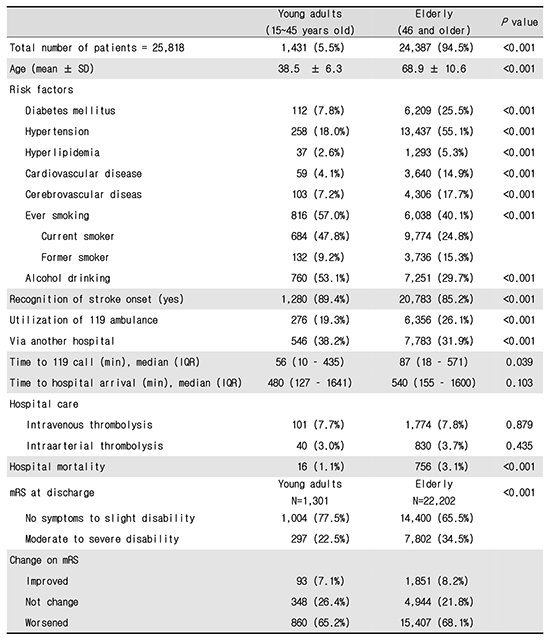2. Hong KS, Bang OY, Kang DW, Yu KH, Bae HJ, Lee JS, Heo JH, Kwon SU, Oh CW, Lee BC, et al. Stroke Statistics in Korea: part I. epidemiology and risk factors: a report from the Korean Stroke Society and Clinical Research Center for Stroke. J Stroke. 2013; 15:2–20.
3. Walker AE, Robins M, Weinfeld FD. The national survey of stroke: clinical findings. Stroke. 1981; 12:I13–I44.
4. Bevan H, Sharma K, Bradley W. Stroke in young adults. Stroke. 1990; 21:382–386.
5. Marini C, Totaro R, De Santis F, Ciancarelli I, Baldassarre M, Carolei A. Stroke in young adults in the community-based L'Aquila registry: incidence and prognosis. Stroke. 2001; 32:52–56.
6. Griffiths D, Sturm J. Epidemiology and etiology of young stroke. Stroke Res Treat. 2011; 2011:209370.
7. Adams HP Jr, Butler MJ, Biller J, Toffol GJ. Nonhemorrhagic cerebral infarction in young adults. Arch Neurol. 1986; 43:793–796.
8. Putaala J, Metso AJ, Metso TM, Konkola N, Kraemer Y, Haapaniemi E, Kaste M, Tatlisumak T. Analysis of 1008 consecutive patients aged 15 to 49 with first-ever ischemic stroke: the Helsinki young stroke registry. Stroke. 2009; 40:1195–1203.
9. Lee SS, Kim SM, Kim WT, Choi IS. Stroke in young adults. J Korean Neurol Assoc. 1991; 9:297–301.
10. Lee GH, Lee WY, Hong SB, Yoon BW, Roh JK, Lee SB, Myung H. Stroke in young adults. J Korean Neurol Assoc. 1993; 11:43–53.
11. Korea Centers for Disease Control & Prevention. Hospital-based registration of cardiovascular disease in South Korea. accessed on 9 October 2013. Available at
https://ccvd.cdc.go.kr/ccvd/index.do.
12. Nencini P, Inzitari D, Baruffi MC, Fratiglioni L, Gagliardi R, Benvenuti L, Buccheri AM, Cecchi L, Passigli A, Rosselli A. Incidence of stroke in young adults in Florence, Italy. Stroke. 1988; 19:977–981.
13. Kleindorfer D, Khoury J, Kissela B, Alwell K, Woo D, Miller R, Schneider A, Moomaw C, Broderick JP. Temporal trends in the incidence and case fatality of stroke in children and adolescents. J Child Neurol. 2006; 21:415–418.
14. George MG, Tong X, Kuklina EV, Labarthe DR. Trends in stroke hospitalizations and associated risk factors among children and young adults, 1995-2008. Ann Neurol. 2011; 70:713–721.
15. Kissela BM, Khoury JC, Alwell K, Moomaw CJ, Woo D, Adeoye O, Flaherty ML, Khatri P, Ferioli S, De Los Rios La Rosa F, et al. Age at stroke: temporal trends in stroke incidence in a large, biracial population. Neurology. 2012; 79:1781–1787.
16. Khang YH, Yun SC. Trends in general and abdominal obesity among Korean adults: findings from 1998, 2001, 2005, and 2007 Korea National Health and Nutrition Examination Surveys. J Korean Med Sci. 2010; 25:1582–1588.
17. Korea Centers for Disease Control & Prevention. Korean Health Statistics 2010: Korea National Health and Nutrition Examination Survey (KNHANESV-1). accessed on 30 August 2012. Available at
http://knhanes.cdc.go.kr/knhanes/index.do.
18. Wolf PA, D'Agostino RB, Kannel WB, Bonita R, Belanger AJ. Cigarette smoking as a risk factor for stroke: the Framingham Study. JAMA. 1988; 259:1025–1029.
19. Abbott RD, Yin Y, Reed DM, Yano K. Risk of stroke in male cigarette smokers. N Engl J Med. 1986; 315:717–720.
21. Love BB, Biller J, Jones MP, Adams HP Jr, Bruno A. Cigarette smoking: a risk factor for cerebral infarction in young adults. Arch Neurol. 1990; 47:693–698.
22. Bhat VM, Cole JW, Sorkin JD, Wozniak MA, Malarcher AM, Giles WH, Stern BJ, Kittner SJ. Dose-response relationship between cigarette smoking and risk of ischemic stroke in young women. Stroke. 2008; 39:2439–2443.
23. Gorelick PB. Alcohol and stroke. Stroke. 1987; 18:268–271.
24. Hillbom M, Kaste M. Ethanol intoxication: a risk factor for ischemic brain infarction. Stroke. 1983; 14:694–699.
25. Gladstone DJ, Rodan LH, Sahlas DJ, Lee L, Murray BJ, Ween JE, Perry JR, Chenkin J, Morrison LJ, Beck S, et al. A citywide prehospital protocol increases access to stroke thrombolysis in Toronto. Stroke. 2009; 40:3841–3844.
26. Nagaraja N, Bhattacharya P, Norris G, Coplin W, Narayanan S, Xavier A, Rajamani K, Chaturvedi S. Arrival by ambulance is associated with acute stroke intervention in young adults. J Neurol Sci. 2012; 316:168–169.





 PDF
PDF ePub
ePub Citation
Citation Print
Print








 XML Download
XML Download